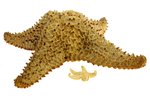
The largest known starfish, the sunflower star (Pycnopodia helianthoides), manages to break several records. It is the largest sea star in terms of arm span, reaching nearly 40 inches from arm tip to arm tip, and is also the heaviest, weighing in at up to 11 pounds. It also has the most arms of any known species.
Physical Characteristics
Aside from the size, it’s the number of arms that sets this sea star apart. Adults have up to 24 arms symmetrically arranged, more than any other known species. Because some individuals are a deep yellow, they do actually look a bit like sunflowers, with all the arms looking like petals. Yellow isn’t the only color—sunflower stars also come in several others, including various shades of purple, orange, red and brown.
Underneath they are somewhat paler with thousands of yellow or orange tubular feet. These feet act like suction cups, giving the sea stars an excellent grip and helping them catch and open their mollusc, sea urchin and crustacean prey. The feet are also used for walking, and this species can move remarkably fast—up to 40 inches a minute, according to Monterey Bay Aquarium.
Habitat
Like other sea stars, sunflower stars are benthic—bottom-dwelling—creatures, living on the sea bed in coastal areas of the Pacific Ocean. They don’t inhabit particularly deep water, usually being found at a depth of less than 400 feet, including within the intertidal zone.
Threats
Mature sunflower stars aren't the easiest meal, but some natural predators will go for them. These include seabirds, sea otters and king crabs. Humans are not a major threat to this species except possibly through water pollution. Although sunflower stars are sometimes viewed as a pest because of their consumption of other invertebrates, they are not hunted by humans on a significant scale.
Defense
Although sea stars don’t have a central nervous system or brains as we think of them, they can communicate. For example, when a predator threatens a sunflower star, the star releases a chemical into the water that acts as a warning to others of its species in the area. Its other main form of defense is to shed an arm that has been grabbed while the rest of the animal makes a fast exit. Shed arms will regrow eventually—in the meantime, the animal has plenty.
Life Cycle
They start off as eggs, which hatch into free-swimming larvae that look nothing like adult sea stars. After about 10 weeks the larvae transform into juvenile sea stars, which don’t have that many arms. In fact, babies have only the more familiar five to start with; they grow more arms as they get bigger. A sixth grows fairly quickly and then new arms start appearing in pairs.
References
Photo Credits
-
Jupiterimages/Photos.com/Getty Images
Writer Bio
Judith Willson has been writing since 2009, specializing in environmental and scientific topics. She has written content for school websites and worked for a Glasgow newspaper. Willson has a Master of Arts in English from the University of Aberdeen, Scotland.




